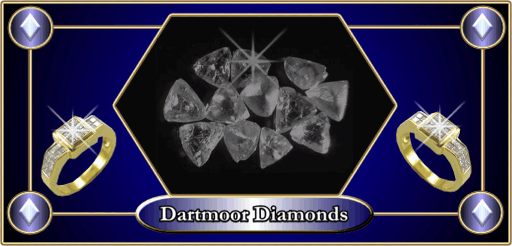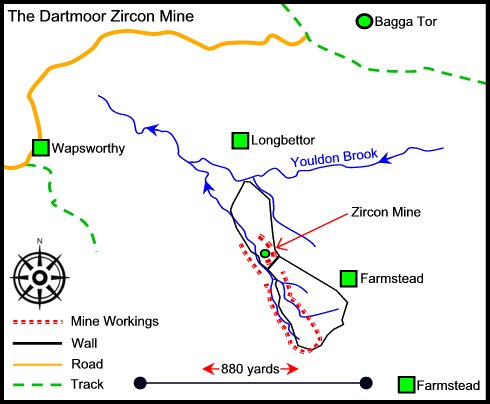
Hidden in a small valley below Bagga tor are the remnants of some old tinners works and amongst these are the vestiges of a one time diamond mine. It sounds beyond belief but they are there, well to be exact it was not genuine diamonds that were being extracted but zircons. Social and economic demands of the time were such that there was a market for cheap imitation diamonds that basically looked the part. I suppose in modern parlance it would be described as ‘bling’, maybe it should be called a ‘Bling Mine’, sounds more interesting.
Sometime back in the early 1900’s a prospector named Jack Cloke was said to have been looking amongst some old tinners spoil heaps for zircons. These were being used as cheap substitutes for genuine diamonds as it was thought that they were hard to distinguish from the ‘real thing’. Richardson, 1992, pp. 14 – 17, describes how he once met Jack Cloke who related his intention to set up a prospect for the stones near Wapsworthy. On a field visit in 1951, Richardson discovered some abandoned workings which he considered to be the zircon prospect. The remains consisted of excavations into the old spoil heaps, a launder, a winch, hut, and an old Ruston Hornsby engine. He later managed to confirm with a local source that these definitely belonged to Cloke and that he did find zircons at the workings.

Richardson returned to the site in 1989 when he found that the engine was still in-situ but much of the other evidence had become overgrown with vegetation, the old hut had also disappeared. There is also evidence to suggest that Cloke was also prospecting for ilmenite which is a form of titanium which at the time of his activities was nothing like as valuable as it is today, its early uses were in paint manufacturing.
I am no mineralologist but the following information describes zircon
Formula: Zr[SiO 4 ]
System: Tetragonal
Colour: Colourless, yellow, …
Lustre: Adamantine Hardness: 7½
Name: Arabic zar – gold, and gun – coloured, alluding to one of the many colours that the mineral may display.
Zirconium Orthosilicate, is found in most igneous rocks and some metamorphic rocks as small crystals or grains. It is also found as alluvial grains in some sedimentary rocks due to its high hardness. Zircon has a high index of refraction and, where crystals are large enough, is often used as a gemstone.
Reading List:
Richardson, P. H. G. 1992 Mines of Dartmoor and the Tamar Valley, The Northern Mine Research Society, Sheffield.
 Legendary Dartmoor The many aspects past and present of Dartmoor
Legendary Dartmoor The many aspects past and present of Dartmoor

I am Editor of “Stone Chat” the free magazine for members and friends of the Norfolk Mineral and Lapidary Society. This is just the type of piece I like for the Magazine, would you be prepare to allow me to reproduce it in my periodical?
I regret we are only a small club and are unable to pay for contribution. Credit to your web site will of course be give, should you agree.
Many thanks for considering my request.
Hi, no problem, help yourself.